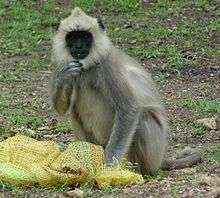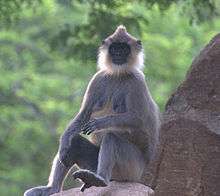Tufted gray langur
| Tufted gray langur[1] | |
|---|---|
 | |
| Tufted gray langur in Mudumalai National Park, Tamil Nadu, India. | |
| Scientific classification | |
| Kingdom: | Animalia |
| Phylum: | Chordata |
| Class: | Mammalia |
| Order: | Primates |
| Family: | Cercopithecidae |
| Genus: | Semnopithecus |
| Species: | S. priam |
| Binomial name | |
| Semnopithecus priam Blyth, 1844 | |
 | |
| Tufted gray langur range | |
The tufted gray langur (Semnopithecus priam), also known as Madras gray langur, and Coromandel sacred langur, is an Old World monkey, one of the species of langurs. This, like other gray langurs, is mainly a leaf-eating monkey. It is found in southeast India and Sri Lanka.[1] It is one of three Semnopithecus species named after characters from The Iliad, S. hector and S. ajax being the others. In Sinhala language, it is known as හැලි වදුරා (Heli wandura).
Body Characteristics
- Head to body length = 55–70 cm.
- Tail length = 75–90 cm.
- Weight of an adult = 11–20 kg.
Males are larger than females.[3]
In Sri Lankan subspecies, dorsal area gray to brownish gray in color, getting darker with the age. Underparts are light grayish. Short whitish beard and sideburns present. The hairs of the crown form a distinct pointed tuft or crest, that meets at a central point, hence the name. Black eyebrows project outward. Head scarcely paler or not paler than back. Hands and feet are same color as limbs.


Evolution
There are two subspecies, Semnopithecus priam thersites in Sri Lanka and the southern Western Ghats in India, and Semnopithecus priam priam from Andhra Pradesh to Tamil Nadu in India.
There are two theories about the evolution of these two subspecies. According to one theory, Semnopithecus priam arose from subspecies Semnopithecus vetulus philbricki. With the glacial fluctuations, and far apart of Indian subcontinent, pushed two taxa apart, but both retained key adaptation to folivory, and a ruminant-like stomach. Thereafter, S. priam invaded India, when there was a land bridge and there split off into two subspecies of S. priam.[3] In the other theory, Sri Lankan subspecies S. priam thersites evolved from the endemic S. vetulus, whereas, Indian subspecies S. priam priam evolved from the S. johnii, which results the genetic variations between two S. priam subspecies.
Habitat
In Sri Lanka, tufted gray langurs are abundant in dry zone forests and also within human dwellings. Many numerous troops are found at archeologically important areas, such as Polonnaruwa, Dambulla, Anuradhapura, and Sigiriya. The animal is also found in southward of the island, such as Hambantota, Yala National Park, and Tissamaharama.
Diet
Mostly folivorous, tufted gray langurs are fond of eating anything vegetarian. They are known to eat fruits and seeds. Langurs are differ from leaf monkeys, where latter is known to eat mature, fleshy fruits, and langurs are like to eat partially drier fibrous fruits. The leaves of Drypetes sepiaria, Dimocarpus longan, Ficus microcarpa, Holoptelea integrifolia, and fruits and seeds of Hydnocarpus venenata, Ficus arnottiana, Macaranga peltata are known to eat by Sri Lankan subspecies.[4][5]
Sometimes, the troops can be seen near the water bodies, where they feed on Nelumbo nucifera seeds.[6] Insects and everygreen leaves are eaten when others foods are less abundant and bark is only eaten when there is no other food available. The Gray Langur’s diet is high in strychnine, which can be harmful to animals. Therefore, it will commonly ingest the gum of the Sterculia urens to counteract the effects. This gum is marketed in England as a prescription laxative known as Normacol.
Ecology
Generally a shy animal, tufted gray langurs are partially arboreal, semi-terrestrial and diurnal in habit. They always finds a way to come to the ground when there is no any danger. Unlike the canopy-dweeling sympatric relatives, they are rather common in urban settlements, found in gardens, and other large fruit trees such as Mangifera indica, and Artocarpus heterophyllus.[2]
Behavior
Tufted gray langurs are mainly philopatric, meaning they are stick to their territories. Single troop may include about 20 to 50 individuals. Large troops are led by both large male-female combinations, whereas small troops are governed by an alpha male. Females are quickly attain their heat to mate with new alpha male, even they are not ready for the reproduction in natural estrous cycle.[7] The group is dominated by a high-ranking male, who usually lasts in the leadership position for an average of 18 months. Often, adolescent males are expelled from the group at an early age and go on to form bachelor groups. These groups will then attack an existing leader in order to over take his group. All of the children of the dominated leader will then be killed. In each group, only the male monkeys that have high-rankings are allowed to mate with any female in the group. The males with lower rankings must sneak their way past a high-ranking male in order to get a chance at copulation with a female.
Female langur gives birth to a single offspring or rarely twins, after a 6 months of gestation period. After birth, offspring is attach to the mother about 3 months with all the nourishment and other protection. Sub adult males and other males usually spend the time with searching for foods, rivals with neighboring alpha males, and protecting the troop. Females spend the time with feeding the young, grooming them, and even play with the young.[8]
Tufted gray langurs communicate with many different ways such as barks, grunts, whoops, whistles and howls. The cough like voice is used for giving tension, and whistling for the contact loss with the troop.[3] The tufted gray langur monkey's superior eyesight and ability to sit atop high trees allows it to spot predators easily. Researchers have noted that this species will often sit next to herds of the spotted deer and notify them when a predator is approaching. Additionally, the langur will often drop fruit from tall trees, which the Spotted Deer will then feed on. In return, the Spotted Deer’s excellent sense of smell allows it to detect predators early on and warn the langur that something may be approaching.
Predators
Leopards, and Black eagles are the major predators of the tufted gray langurs. Other than them, siblings and sub adults are attacked by tigers, dhole, gray wolves, mugger crocodile, and Indian rock python occasionally.[9]
Conservation
According to IUCN Red List, tufted gray langur is listed as a "Near Threatened" species, due to decline of populations in recent years. Hunting and habitat destruction also affect for the declining of the species. Some people also fond of eating langur meat in some parts of Sri Lanka. Very few occasions are recorded of being captured for pets. Numerous conservations projects are undertaken in both Sri Lankan and Indian forests and sanctuaries.[2]
Subspecies thersites is listed as "Endangered", and priam as "Near Threatened".
References
- 1 2 Groves, C.P. (2005). Wilson, D.E.; Reeder, D.M., eds. Mammal Species of the World: A Taxonomic and Geographic Reference (3rd ed.). Baltimore: Johns Hopkins University Press. p. 175. OCLC 62265494. ISBN 0-801-88221-4.
- 1 2 3 Molur, S.; Singh, M. & Kumar, A. (2008). "Semnopithecus priam". IUCN Red List of Threatened Species. Version 2008. International Union for Conservation of Nature. Retrieved 4 January 2009.
- 1 2 3 Yapa, A.; Ratnavira, G. (2013). Mammals of Sri Lanka. Colombo: Field Ornithology Group of Sri Lanka. p. 1012. ISBN 978-955-8576-32-8.
- ↑ Rajnish P. Vandercone, Chameera Dinadh, Gayan Wijethunga, Kitsiri Ranawana, David T. Rasmussen (December 2012). Dietary Diversity and Food Selection in Hanuman Langurs (Semnopithecus entellus) and Purple-Faced Langurs (Trachypithecus vetulus) in the Kaludiyapokuna Forest Reserve in the Dry Zone of Sri Lanka. International Journal of Primatology 33 (6): 1382-1405.
- ↑ "Primate Ecology and Behavior Project". Rajnish Vandercone, Arun Bandara, Gihan Jayaweera. Retrieved 1 May 2015.
- ↑ http://www.masterfile.com/stock-photography/image/841-06344375/Tufted-gray-langur-eating-lotus-flower-(semnopithecus-priam)--Anuradhapura-Sri-Lanka
- ↑ http://www.academia.edu/7380899/Abnormal_mating_behaviour_of_Tufted_grey_langur_Semnopithecus_priam_at_Kalakad-Mundanthurai_Tiger_Reserve_Tamil_Nadu
- ↑ http://indiabiodiversity.org/species/show/262369
- ↑ http://pin.primate.wisc.edu/factsheets/entry/gray_langur/taxon
